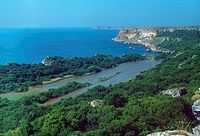
Geographical position of Balkan mixed forests ecoregion
The Balkan mixed forests constitute a terrestrial ecoregion of Europe according to both the WWF and Digital Map of European Ecological Regions by the European Environment Agency. It belongs in the Temperate broadleaf and mixed forests Biome and the Palearctic ecozone.
Distribution
The Balkan mixed forests cover much of the valleys, plains and mountain slopes of the eastern Balkans on different altitudes (except higher parts of the Rhodope and Balkan Mountains, where they are substituted by the Rodope montane mixed forests), extend from approximately the Drina valley to the coasts of the Black, Marmara and Aegean Seas and occupy 224,400 km² (86,600 sq. mi) in Turkey, Greece, the Republic of Macedonia, Bulgaria, Romania, Serbia (Kosovo). The ecoregion is surrounded by the Euxine-Colchic deciduous forests (in Turkey, Georgia and Bulgaria), Aegean and Western Turkey sclerophyllous and mixed forests (in Greece), Pindus Mountains mixed forests (in Greece, the Republic of Macedonia and Albania), Dinaric Mountains mixed forests (in Montenegro and Bosnia and Herzegovina), Pannonian mixed forests (in Bosnia and Herzegovina, Serbia and Romania), Carpathian montane conifer forests, Central European mixed forests (both in Romania), as well as the East European forest steppe and Pontic steppe (both situated in Romania and Bulgaria).
Description
The climate of the ecoregion is mostly of Köppen's humid subtropical (Cfa) to humid warm summer continental (Dfb) type, with wet winters. Some areas of relatively high rainfall have been considered a temperate rainforest relict.
Several species of deciduous oaks (most prominently Quercus frainetto Ten., as well as Q. cerris L., Q. pubescens Willd. and others) dominate most of the ecoregion's forests, interspersed higher up mountainsides (above 800–1200 m) mostly with European Beech and such conifers as Scots Pine, Bosnian pine, Macedonian Pine, Silver Fir and Norway Spruce. The highest peaks support alpine tundra vegetation.
Phytogeographically, the ecoregion is shared between parts of the Central European, Illyrian and Euxinian provinces of the Circumboreal Region within the Holarctic Kingdom (according to Armen Takhtajan's delineation).
External links
| |
| Apennine deciduous montane forests |
Italy |
| Atlantic mixed forests |
Denmark, France, Belgium, Germany, Netherlands |
| Azores temperate mixed forests |
Portugal |
| Balkan mixed forests |
Bulgaria, Greece, Macedonia, Romania, Serbia, Turkey |
| Baltic mixed forests |
Sweden, Denmark, Germany, Poland |
| Cantabrian mixed forests |
Spain, Portugal |
| Caspian Hyrcanian mixed forests |
Iran, Azerbaijan |
| Caucasus mixed forests |
Georgia, Armenia, Azerbaijan, Russia, Turkey |
| Celtic broadleaf forests |
United Kingdom, Ireland |
| Central Anatolian deciduous forests |
Turkey |
| Central China loess plateau mixed forests |
China |
| Central European mixed forests |
Austria, Germany, Lithuania, Moldova, Poland, Belarus, Czech Republic |
| Central Korean deciduous forests |
North Korea, South Korea |
| Changbai Mountains mixed forests |
China, North Korea |
| Changjiang Plain evergreen forests |
China |
| Crimean Submediterranean forest complex |
Russia, Ukraine |
| Daba Mountains evergreen forests |
China |
| Dinaric Mountains mixed forests |
Albania, Bosnia and Herzegovina, Italy, Montenegro, Serbia, Slovenia, Croatia |
| East European forest steppe |
Bulgaria, Moldova, Romania, Russia, Ukraine |
| Eastern Anatolian deciduous forests |
Turkey |
| English Lowlands beech forests |
United Kingdom |
| Euxine-Colchic deciduous forests |
Bulgaria, Georgia, Turkey |
| Hokkaido deciduous forests |
Japan |
| Huang He Plain mixed forests |
China |
| Madeira evergreen forests |
Portugal |
| Manchurian mixed forests |
China, North Korea, Russia, South Korea |
| Nihonkai evergreen forests |
Japan |
| Nihonkai montane deciduous forests |
Japan |
| North Atlantic moist mixed forests |
Ireland, United Kingdom |
| Northeast China Plain deciduous forests |
China |
| Pannonian mixed forests |
Austria, Bosnia and Herzegovina, Czech Republic, Hungary, Romania, Serbia, Slovakia, Slovenia, Ukraine, Croatia |
| Po Basin mixed forests |
Italy |
| Pyrenees conifer and mixed forests |
France, Spain, Andorra |
| Qin Ling Mountains deciduous forests |
China |
| Rodope montane mixed forests |
Bulgaria, Greece, Macedonia, Serbia |
| Sarmatic mixed forests |
Russia, Sweden, Norway, Denmark, Finland, Lithuania, Latvia, Estonia, Belarus |
| Sichuan Basin evergreen broadleaf forests |
China |
| South Sakhalin-Kurile mixed forests |
Russia |
| Southern Korea evergreen forests |
South Korea |
| Taiheiyo evergreen forests |
Japan |
| Taiheiyo montane deciduous forests |
Japan |
| Tarim Basin deciduous forests and steppe |
China |
| Ussuri broadleaf and mixed forests |
Russia |
| West Siberian broadleaf and mixed forests |
Russia |
| Western European broadleaf forests |
Switzerland, Austria, France, Germany, Czech Republic |
| Zagros Mountains forest steppe |
Iran, Arabian Peninsula |

